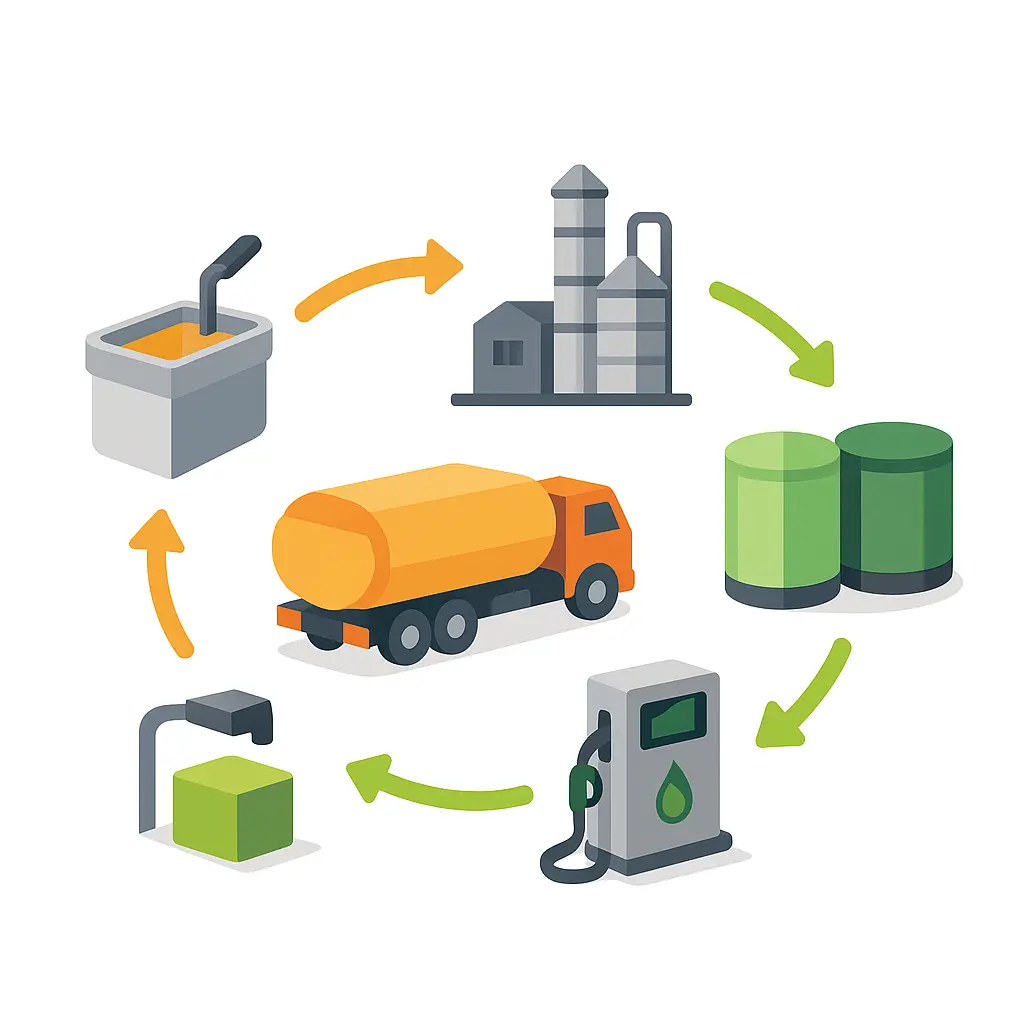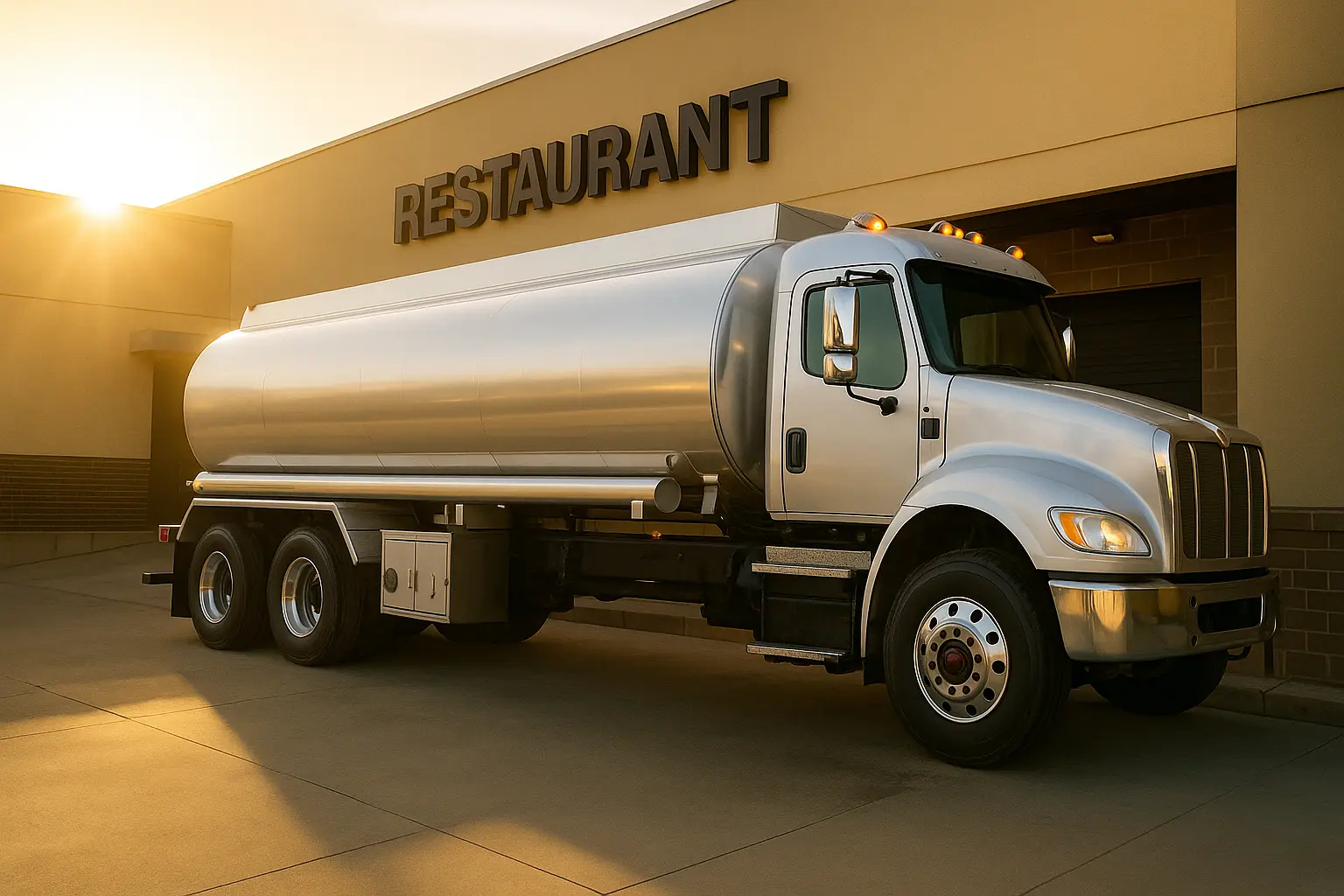Table of Contents
Snapshot answers
A UCO recycler is part waste hauler, part refinery supplier, part environmental compliance partner. It:
- Collects used cooking oil safely from restaurants and food producers.
- Transports & logs every gallon under state FOG regulations.
- Pre processes the oil filtering, de watering, and testing quality.
- Upcycles it into new products (chiefly biodiesel) or sells it as feedstock to bio refineries.
- Documents the chain of custody for regulators and pays (or credits) the generator.
- Guards assets from grease theft, which has surged because UCO now trades like a commodity.
Why used cooking oil is more than “trash”
Pouring fryer oil down a drain creates clogs and fatbergs; tossing it in the trash wastes a valuable low carbon feedstock. The U.S. DOE lists UCO alongside animal fats as a prime biodiesel input because it cuts lifecycle CO₂ emissions by roughly 74 percent compared with petroleum diesel. With airlines and refiners (e.g., Galp Energia) investing hundreds of millions in HVO and sustainable aviation fuel plants that run on waste oils, demand keeps climbing.
Take away: Restaurants now handle a product that’s part environmental hazard, part renewable energy currency. A recycling company manages both sides.
The job, stage by stage
| Stage | What happens | Tools & tech |
|---|---|---|
| 1. Container supply & training | Company installs indoor caddies or outdoor lockable tanks, trains kitchen staff to avoid contamination. | RFID‑tagged bins, anti‑theft locks. |
| 2. Scheduled collection | Licensed driver pumps or lifts oil into an insulated vacuum truck, usually between midnight and dawn to avoid service disruptions. | Route‑optimization software, digital volume scanners. |
| 3. Transport & manifesting | Every pickup is logged (date, volume, source) to satisfy local FOG ordinances. | E‑manifests, GPS‑tracked fleets. |
| 4. Pre‑processing | At the depot the oil is heated, filtered, centrifuged, and tested for free‑fatty‑acid (FFA) level. | Inline spectrometry, centrifuges, heat exchangers. |
| 5. Refining or resale | High‑grade oil goes to on‑site transesterification or is sold to a bio‑refinery. Lower grades become animal‑feed fats, soaps, or lubricants. | Reactors, methanol recovery, glycerin separation. |
| 6. Reporting & payment | Generator receives a statement and, if under a revenue‑share model, a rebate based on current UCO spot prices. | Customer portal, automated ACH payout. |
Core responsibilities in detail
Safety & compliance FOG regulations:
Cities like Miami cap grease in restaurant effluent at 300 mg/L and require proof of proper hauling.
EPA & DOT rules: Transporters carry Department of Transportation hazmat endorsements and maintain spill response kits.
Environmental stewardship
Every 100 lbs of UCO diverted from waste can yield roughly the same weight of biodiesel plus 10 lbs of glycerin.
Prevents sewer blockages that cost cities millions to clear.
Economic partner
Many recyclers pay kitchens per gallon; others offset fresh oil deliveries.
High commodity value fuels a black market Buffalo Biodiesel reported $20 million in losses from grease theft in 2024.
Security & asset protection
Locking lids, QR code scanning, geofencing, and even night vision cameras deter siphoning crews.
How a recycler turns grease into fuel (plain English science)

- Filtering & heating removes food particles and water.
- Transesterification mixes oil with methanol and a catalyst (NaOH/KOH). Triglycerides split, producing methyl esters (biodiesel) and glycerin.
- Purification washes and polishes the biodiesel to meet ASTM D6751 or EN 14214 specs.
- Distribution ships B100 or blends (B20, B5) to fuel distributors or fleets.
Why restaurants choose professional recyclers
| Benefit | Impact |
|---|---|
| Compliance peace‑of‑mind | No fines for improper disposal; manifests satisfy health inspectors. |
| Cleaner kitchens | Closed systems reduce slips and odors. |
| Revenue stream | Rebates or free fresh‑oil delivery offset costs. |
| Brand sustainability | Grease diverted to low‑carbon fuel counts toward ESG metrics. |
Choosing a reliable UCO partner
- Check licensing and insurance certificates
- Ask for spill response and theft prevention protocols
- Compare payment structures (fixed per gallon vs. indexed)
- Review customer portal demo look for real time pickup logs
- Verify final destination (renderer vs. certified bio refinery)
Quick FAQs
Do recyclers pay me for my oil? Often yes rates track commodity markets and oil quality.
Is used cooking oil hazardous waste? No, but it becomes a regulated material once stored for collection.
How often will they pick up? Anywhere from weekly to quarterly, based on volume and container size.
What happens to contaminants like water or crumbs? They are separated in centrifuges and sent to anaerobic digesters or are land applied per local rules.
Looking ahead
Demand for waste based feedstocks is outpacing supply as airlines trial 100 percent SAF flights and new HVO plants (e.g., Galp’s 270 k t/y unit) come online in 2026. Expect recyclers to adopt blockchain traceability and AI based route planning to squeeze every gram of carbon and cost.
Bottom line
A used cooking oil recycling company is the engine that keeps sewers clear, saves kitchens money, and supplies the biofuel boom. Partner wisely and your fryer’s leftovers go from liability to low carbon asset turning yesterday’s fries into tomorrow’s flight fuel.









